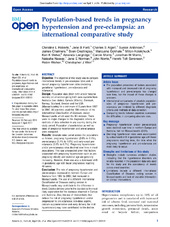| dc.description.abstract | Objective: The objective of this study was to compare international trends in pre-eclampsia rates and in overall pregnancy hypertension rates (including gestational hypertension, pre-eclampsia and eclampsia). Design: Population data (from birth and/or hospital records) on all women giving birth were available from Australia (two states), Canada (Alberta), Denmark, Norway, Scotland, Sweden and the USA (Massachusetts) for a minimum of 6 years from 1997 to 2007. All countries used the 10th revision of the International Classification of Diseases, except Massachusetts which used the 9th revision. There were no major changes to the diagnostic criteria or methods of data collection in any country during the study period. Population characteristics as well as rates of pregnancy hypertension and pre-eclampsia were compared. Results: Absolute rates varied across the populations as follows: pregnancy hypertension (3.6% to 9.1%), pre-eclampsia (1.4% to 4.0%) and early-onset preeclampsia (0.3% to 0.7%). Pregnancy hypertension and/or pre-eclampsia rates declined over time in most populations. This was unexpected given that factors associated with pregnancy hypertension such as prepregnancy obesity and maternal age are generally increasing. However, there was also a downward shift in gestational age with fewer pregnancies reaching 40 weeks. Conclusion: The rate of pregnancy hypertension and pre-eclampsia decreased in northern Europe and Australia from 1997 to 2007, but increased in Massachusetts. The use of a different International Classification of Diseases coding version in Massachusetts may contribute to the difference in trend. Elective delivery prior to the due date is the most likely explanation for the decrease observed in Europe and Australia. Also, the use of interventions that reduce the risk of pregnancy hypertension and/or progression to pre-eclampsia (low-dose aspirin, calcium supplementation and early delivery for mild hypertension) may have contributed to the decline. | en_US |

